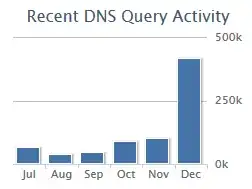I used my own server to host an example file (an image) when I posted an answer to a question at StackOverflow. Now someone has copied the code I used, including the URL to the file on my server. The site they are using it on is relatively high volume, so this is causing unnecessary strain on my measly virtual server, and above all it's eating severely off my monthly DNS query limit.

I have no problem with the hotlinking per se, I'm just worried I'll end up paying more for something I'm not responsible of and it distorts the actual usage so I cannot monitor what I actually use. What measures can I take to prevent the site from generating so much hits on the services I have paid for? What I have tried so far:
- Contacting the company where the requests originate - no reply.
- Replacing the hosted file with another obnoxious one - but they don't actually use the image anywhere, just link to it in their CSS so this method is not effective as it's not visible anywhere on their page.
- Blocking certain IPs with iptables: this prevents the requests from reaching Apache but they still hit the DNS.
Am I defenseless to this kind of abuse? Do I just have to hope that they'll remove the image eventually? At least I've learned never to use my own server to host anything that others can directly incorporate into their own works..